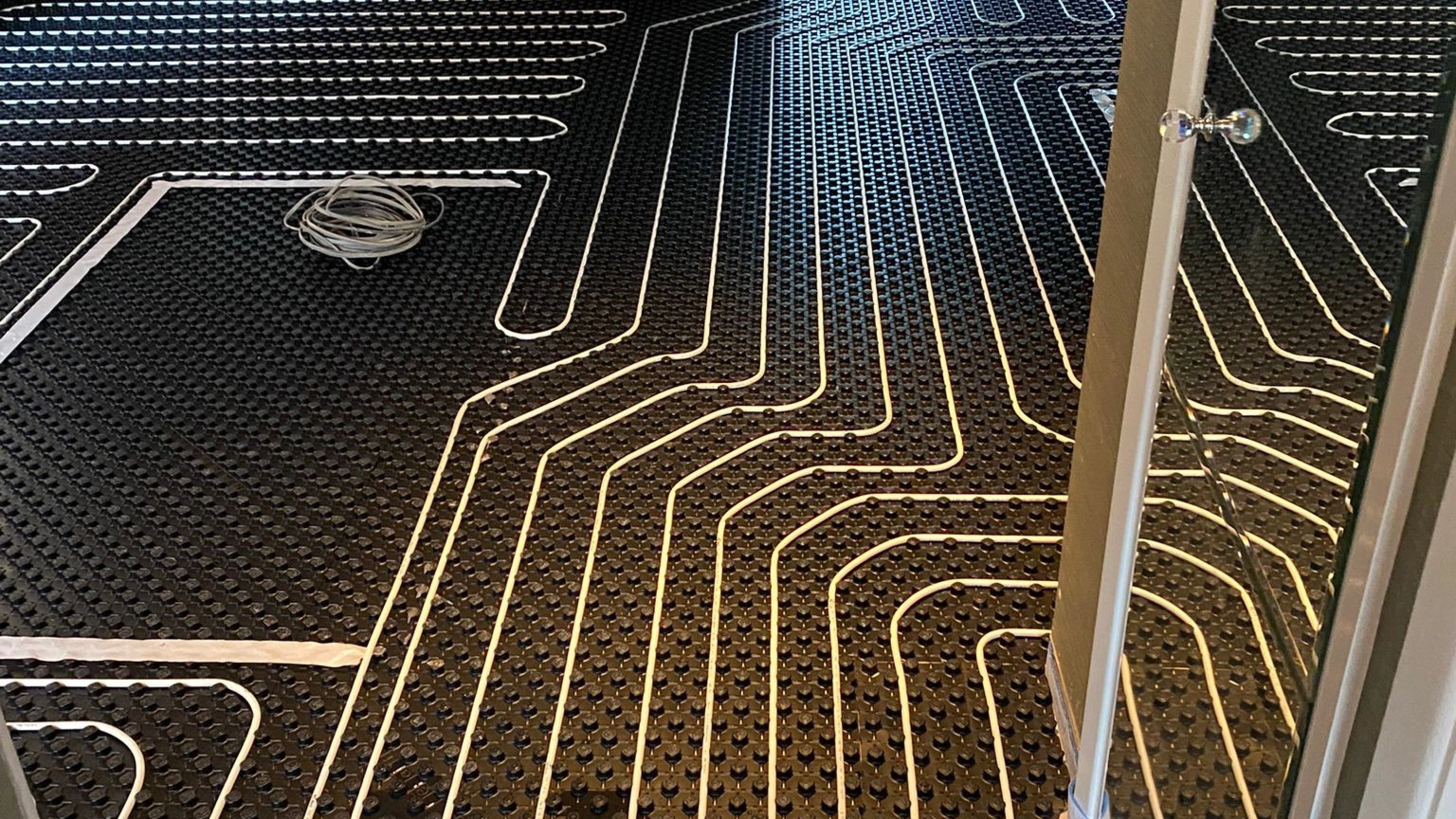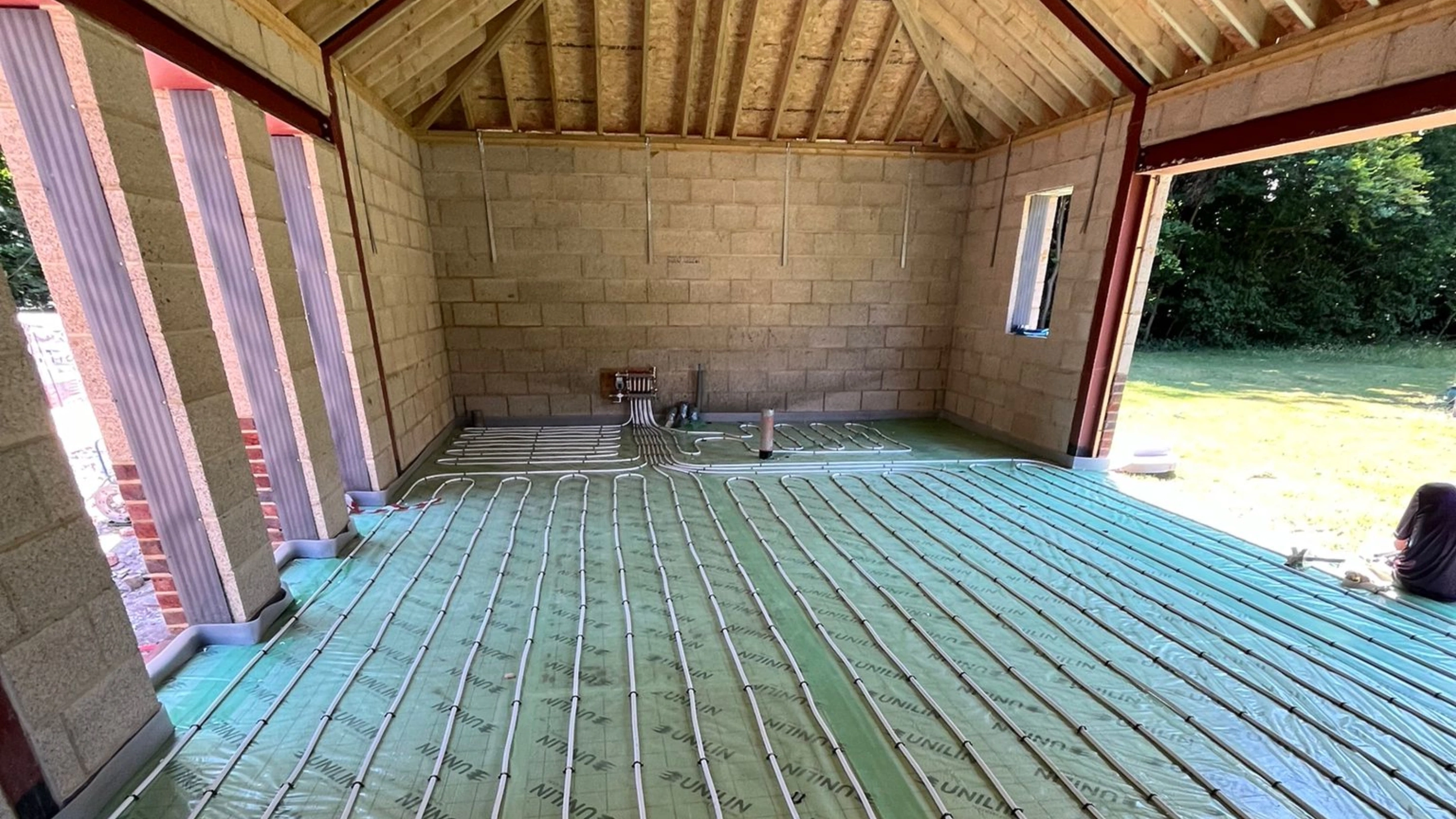Recent Underfloor heating projects
Why underfloor heating?
Underfloor heating offers numerous advantages, making it an increasingly popular choice for modern homes and businesses.
One of the key benefits is its energy efficiency, as it operates at lower temperatures while evenly distributing heat, resulting in reduced energy consumption and lower heating bills.
Unlike traditional radiators, underfloor heating frees up wall space, allowing for more design flexibility in rooms. It also provides a more comfortable and consistent warmth, eliminating cold spots and draughts. Additionally, underfloor heating is compatible with various floor coverings, including tiles, wood, and carpets, making it a versatile option for any property.

The 2 main types of underfloor heating
There are two main types of underfloor heating systems: wet (hydronic) and electric.
Wet systems use water-filled pipes connected to the central heating system, which makes them more energy-efficient and cost-effective for heating larger areas, such as whole homes or open-plan spaces. However, they tend to have higher upfront installation costs and are more complex to retrofit in existing buildings.
Electric underfloor heating, on the other hand, is easier and quicker to install, making it ideal for smaller spaces or individual rooms like bathrooms or kitchens. It’s typically cheaper to install but can be more expensive to run, especially over large areas, as it consumes more electricity.
Each system has its own advantages, and the choice depends on factors like the size of the space, budget, and heating requirements.

Energy Savings and Environmental Benefits of Underfloor Heating
Underfloor heating is an energy-efficient heating solution that can significantly reduce energy consumption compared to traditional radiators.
It operates at lower temperatures while maintaining a comfortable and consistent warmth, leading to reduced energy use and lower heating bills.
Its efficiency is further enhanced when paired with renewable energy sources like heat pumps, which work by extracting heat from the air or ground. Since underfloor heating systems operate at low temperatures, they are perfectly suited for use with air-source or ground-source heat pumps, creating a highly sustainable heating system. This combination not only lowers energy costs but also reduces the environmental impact by decreasing carbon emissions, making it an eco-friendly choice for homeowners looking to reduce their carbon footprint.

Underfloor heating near you
- Camden Town
- Central London
- Cheam
- Cranleigh
- Dorking
- Epsom
- Fulham
- Guildford
- Lambeth
- Leatherhead
- Merton
- Mordon
- Ockley
- Putney
- Raynes park
- Reigate
- Sutton
- Wandsworth
- Wimbledon
- Worcester Park
Frequently asked
- How does underfloor heating work?Underfloor heating uses a network of pipes (wet systems) or electric heating elements (dry systems) beneath the floor to heat a space from the ground up. It distributes heat evenly across the floor surface, creating a comfortable and energy-efficient environment.
- What are the benefits of underfloor heating over traditional radiators?Underfloor heating offers more even heat distribution, improved energy efficiency, and eliminates the need for bulky radiators, freeing up wall space. It also creates a more comfortable environment by reducing cold spots and drafts.
- Is underfloor heating suitable for all types of flooring?Yes, underfloor heating is compatible with most flooring types, including tiles, stone, wood, laminate, and even carpet. However, some materials, like wood, may require specific precautions to avoid damage from heat.
- Can underfloor heating be used in existing buildings, or is it only for new builds?Underfloor heating can be installed in both new builds and existing properties. Retrofitting may require adjustments to the floor height or involve removing existing flooring, but it's a feasible option for most homes and businesses.
- How energy-efficient is underfloor heating?Underfloor heating is highly energy-efficient because it operates at lower temperatures compared to traditional radiators. It spreads heat more evenly, reducing heat loss and helping to lower energy bills.
- What is the difference between wet and electric underfloor heating systems?Wet systems use water-filled pipes connected to your central heating system, while electric systems use cables or heating mats. Wet systems are typically more cost-effective for larger spaces, while electric systems are often easier to install in smaller areas or individual rooms.
- Does underfloor heating take longer to heat up than radiators?Yes, underfloor heating may take longer to heat up initially because it warms the floor mass first. However, once it reaches the desired temperature, it maintains warmth more consistently and efficiently than radiators.
- Is underfloor heating safe for homes with children and pets?Yes, underfloor heating is safe for homes with children and pets. The heat is evenly distributed and gentle, reducing the risk of burns or hot surfaces compared to traditional radiators.
- How easy is it to control underfloor heating?Underfloor heating systems can be controlled using thermostats, which allow you to set specific temperatures for different rooms or zones. Many modern systems are compatible with smart home technology, enabling remote control via mobile apps.
- What maintenance is required for underfloor heating?Underfloor heating requires minimal maintenance. Wet systems may need occasional checks for leaks, while electric systems are low-maintenance once installed. It's important to ensure proper installation to avoid issues down the line.








